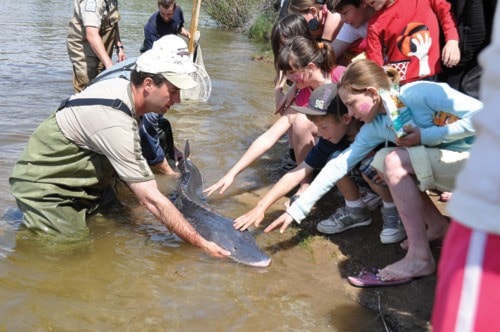The September 2012 Nechako Environmental Enhancement Fund (NEEF) recommended that $4 million be made available for the “operation of a Nechako White Sturgeon Conservation Hatchery as directed by the Nechako White Sturgeon Recovery Initiative (NWSRI).” This funding, although supposedly available for use is actually out of reach, according to Don Peterson, President of the Freshwater Fisheries Society of B.C. (FFSBC).
“None of the resources identified by NEEF are available to groups unless there’s a third party providing matching dollars,” explains Peterson. “We are extremely concerned. Because of the poor economic situation in the province, it is extremely unlikely that the province will be able to come forward with any funding to match the NEEF offer.”
The NEEF report describes the Nechako White Sturgeon as being on the verge of immediate extinction. The NEEF report states that, “There is a very real urgency and need for immediate action if this population is to become naturally self-sustaining once again.”
Wayne Salewski of the NWSRI community working group says that the genetically unique species is at a tipping point. With the species down to approximately 400 fish, from an estimated high of at least 6,000, recovery may quickly become impossible. “If we don’t put this one together, we’re finished here,” Salewski says.
For Salewski the decision to set up the NEEF as a matching dollars fund was an irresponsible decision because it clouds the issue of who is responsible for the conservation effort. “The government should really be looking after this, not leaving it up entirely to local stake holders,” says Saleswki.
Peterson describes how recovery efforts like the one described in the NEEF report have been successful in other parts of the province. “We have two recovery stations, one in the Kootney River and one in the Columbia River. In both those cases, 100 per cent of the cost are paid for by the industrial partners; BC Hydro and the Bonneville Power Administration.” The Bonneville Power Administration is a U.S. federal agency.
Unfortunately, successful conservation efforts in other parts of the province cannot help with local efforts to conserve the Nechako White Sturgeon. “They [the Nechako white sturgeon] cannot be moved in from any other area because they’re a genetically unique population that has evolved in the Nechako River,” says Peterson. “This is a population of fish that has been around since the last ice age.”
Despite more than 20 years of effort, Peterson says that, “unless we get some strong signal that funding will be forthcoming in the future, we will be in the position of having to stop the work we’re doing and just accept the fact that the parties involved are going to let this species go extinct.”
Salewski shares Peterson’s frustration. “We need Rio Tinto to step forward here and put that funding in place to finish off the hard work that’s [already] been done.”
In 1952 the Kenney Dam was constructed to provide power generation to Rio Tinto Alcan operations in Kitimat, B.C. The dam severely impacted the flow of the Nechako River, and according to the NWSRI website, this may have substantially influenced the decline of the white sturgeon. Rio Tinto Alcan was not available for comment at press time but yearly reports published by the NWSRI indicate that Rio Tinto Alcan has been a contributing partner to the sturgeon initiative in the past.



